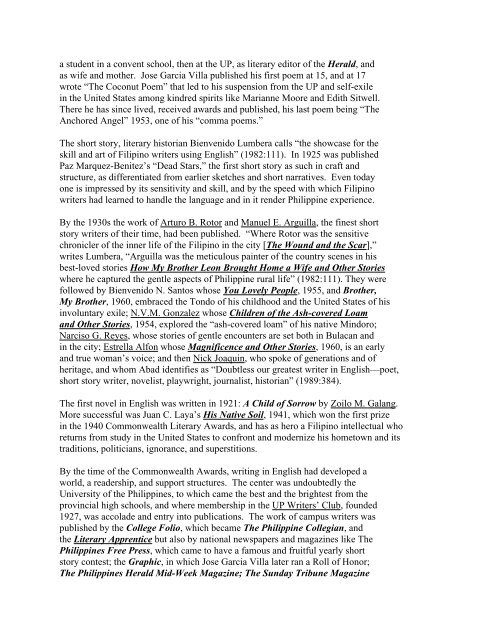LITERATURE IN ENGLISH Philippine literature in English is ...
LITERATURE IN ENGLISH Philippine literature in English is ...
LITERATURE IN ENGLISH Philippine literature in English is ...
You also want an ePaper? Increase the reach of your titles
YUMPU automatically turns print PDFs into web optimized ePapers that Google loves.
a student <strong>in</strong> a convent school, then at the UP, as literary editor of the Herald, and<br />
as wife and mother. Jose Garcia Villa publ<strong>is</strong>hed h<strong>is</strong> first poem at 15, and at 17<br />
wrote “The Coconut Poem” that led to h<strong>is</strong> suspension from the UP and self-exile<br />
<strong>in</strong> the United States among k<strong>in</strong>dred spirits like Marianne Moore and Edith Sitwell.<br />
There he has s<strong>in</strong>ce lived, received awards and publ<strong>is</strong>hed, h<strong>is</strong> last poem be<strong>in</strong>g “The<br />
Anchored Angel” 1953, one of h<strong>is</strong> “comma poems.”<br />
The short story, literary h<strong>is</strong>torian Bienvenido Lumbera calls “the showcase for the<br />
skill and art of Filip<strong>in</strong>o writers us<strong>in</strong>g <strong>Engl<strong>is</strong>h</strong>” (1982:111). In 1925 was publ<strong>is</strong>hed<br />
Paz Marquez-Benitez’s “Dead Stars,” the first short story as such <strong>in</strong> craft and<br />
structure, as differentiated from earlier sketches and short narratives. Even today<br />
one <strong>is</strong> impressed by its sensitivity and skill, and by the speed with which Filip<strong>in</strong>o<br />
writers had learned to handle the language and <strong>in</strong> it render <strong>Philipp<strong>in</strong>e</strong> experience.<br />
By the 1930s the work of Arturo B. Rotor and Manuel E. Arguilla, the f<strong>in</strong>est short<br />
story writers of their time, had been publ<strong>is</strong>hed. “Where Rotor was the sensitive<br />
chronicler of the <strong>in</strong>ner life of the Filip<strong>in</strong>o <strong>in</strong> the city [The Wound and the Scar],”<br />
writes Lumbera, “Arguilla was the meticulous pa<strong>in</strong>ter of the country scenes <strong>in</strong> h<strong>is</strong><br />
best-loved stories How My Brother Leon Brought Home a Wife and Other Stories<br />
where he captured the gentle aspects of <strong>Philipp<strong>in</strong>e</strong> rural life” (1982:111). They were<br />
followed by Bienvenido N. Santos whose You Lovely People, 1955, and Brother,<br />
My Brother, 1960, embraced the Tondo of h<strong>is</strong> childhood and the United States of h<strong>is</strong><br />
<strong>in</strong>voluntary exile; N.V.M. Gonzalez whose Children of the Ash-covered Loam<br />
and Other Stories, 1954, explored the “ash-covered loam” of h<strong>is</strong> native M<strong>in</strong>doro;<br />
Narc<strong>is</strong>o G. Reyes, whose stories of gentle encounters are set both <strong>in</strong> Bulacan and<br />
<strong>in</strong> the city; Estrella Alfon whose Magnificence and Other Stories, 1960, <strong>is</strong> an early<br />
and true woman’s voice; and then Nick Joaqu<strong>in</strong>, who spoke of generations and of<br />
heritage, and whom Abad identifies as “Doubtless our greatest writer <strong>in</strong> <strong>Engl<strong>is</strong>h</strong>—poet,<br />
short story writer, novel<strong>is</strong>t, playwright, journal<strong>is</strong>t, h<strong>is</strong>torian” (1989:384).<br />
The first novel <strong>in</strong> <strong>Engl<strong>is</strong>h</strong> was written <strong>in</strong> 1921: A Child of Sorrow by Zoilo M. Galang.<br />
More successful was Juan C. Laya’s H<strong>is</strong> Native Soil, 1941, which won the first prize<br />
<strong>in</strong> the 1940 Commonwealth Literary Awards, and has as hero a Filip<strong>in</strong>o <strong>in</strong>tellectual who<br />
returns from study <strong>in</strong> the United States to confront and modernize h<strong>is</strong> hometown and its<br />
traditions, politicians, ignorance, and superstitions.<br />
By the time of the Commonwealth Awards, writ<strong>in</strong>g <strong>in</strong> <strong>Engl<strong>is</strong>h</strong> had developed a<br />
world, a readership, and support structures. The center was undoubtedly the<br />
University of the <strong>Philipp<strong>in</strong>e</strong>s, to which came the best and the brightest from the<br />
prov<strong>in</strong>cial high schools, and where membership <strong>in</strong> the UP Writers’ Club, founded<br />
1927, was accolade and entry <strong>in</strong>to publications. The work of campus writers was<br />
publ<strong>is</strong>hed by the College Folio, which became The <strong>Philipp<strong>in</strong>e</strong> Collegian, and<br />
the Literary Apprentice but also by national newspapers and magaz<strong>in</strong>es like The<br />
<strong>Philipp<strong>in</strong>e</strong>s Free Press, which came to have a famous and fruitful yearly short<br />
story contest; the Graphic, <strong>in</strong> which Jose Garcia Villa later ran a Roll of Honor;<br />
The <strong>Philipp<strong>in</strong>e</strong>s Herald Mid-Week Magaz<strong>in</strong>e; The Sunday Tribune Magaz<strong>in</strong>e
















